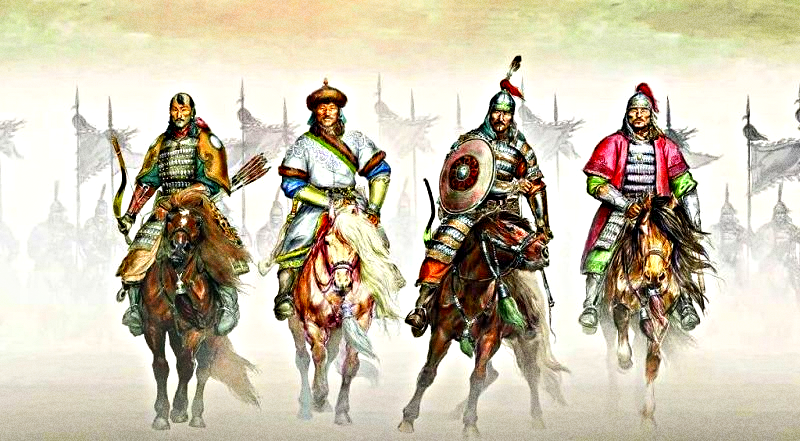The clash between the Kipchaks and the Mongols was inevitable
The Kipchak tribes occupied a vast territory from the Irtysh in the east to the Danube in the west. This territory was called «Desht-i Kipchak» (Kipchak Steppe) by Eastern authors. The natural border between Eastern and Western Desht-i Kipchak was the Volga River.
The Kipchak tribes were heirs of ancient Turkic state traditions. This can be traced by the presence of the dynastic family Yelbori in the Kipchaks (Ashina in the ancient Turks), the identity in the ancient Turkic titulature of the Kimeks and Kipchaks (Shad-tutuk, Baigu, Hakan).
The numerous and belligerent Kipchaks allowed them to significantly expand their territorial possessions and to keep them for several centuries from the encroachments of powerful neighbors in the face of Khorezm, Kievan Rus, and the state formations of the Oguzes, Karluk, Karukhanids, Karakitai, Naimans, and Kereits. However, at the beginning of the XIII century the political situation changed dramatically due to the growing power of the tribal union of Mongols in the east led by Genghis Khan.
The Mongols’ successes in conquering neighboring territories inevitably brought the borders of the Mongol Empire closer to the borders of Eastern Desht-i Kipchak, and a clash was inevitable.
The campaign to Central Asia and the Kipchak domains
The first appearance of the Mongols on the border of the Kipchak domains dates back to 1211, when the Mongols led by Khubilai-noyon appeared in Semirechye. The leader of the Karluks, Arslan-bek, came over to the side of the Mongols. However, many years of war in China prevented Genghis Khan from continuing westward.
In 1216 Genghis Khan’s eldest son Dzhuchi sent his troops to the Turgai steppes in pursuit of the retreating Merkits, the Mongols’ worst enemies.
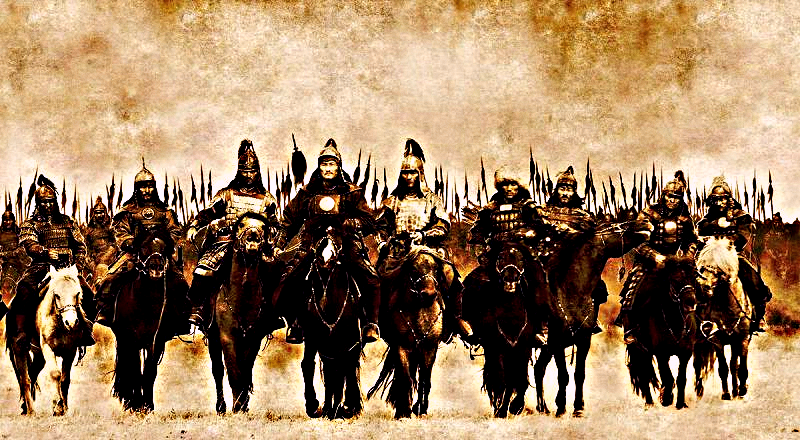
Merkits were supported by Kipchaks, however Djuchi managed to break them. On the Irgiz River there was an accidental meeting of Mongolian troops of Juchi and troops of Khorezmshah Mohammed. Juchi, having less forces and not having received instructions to enter the war with Khorezm, avoided the battle. But Khorezm Shah forced him to fight. The battle did not reveal the winner, Juchi under the cover of night fled, leaving Muhammad bewildered and confused.
Two years later, in 1218, the Mongols led by Dzhebe-noyon returned to Semirechye and expelled the Naiman Khan Kuchluk, who usurped the Karakitai throne.
Following this, Genghis Khan sent a trade caravan of 450 people to Otrar. In the summer of 1218 the caravan arrived in Otrar. The ruler of Otrar Gayir-sultan Inalchik suspected the merchants of espionage, ordered to kill them and loot the caravan. Genghis Khan indignant at the actions of Gayir-sultan sent his ambassadors demanding his extradition. However, Khorezmshah did not extradite the Sultan and ordered to kill the Mongolian ambassadors. This deeply angered Genghis Khan, who secluded himself for three days asking Heaven to punish the Central Asians.
«In this blaze of anger he climbed alone to the top of a hill, threw a girdle around his neck, bared his head, and pressed his face to the ground. For three twenty-four hours he prayed and wept, [turning] to heaven and saying, ‘O Eternal Heaven! O Creator of the Taziks [i.e., the Tajiks, as the Persian-speaking peoples were then called] and the Turks! I was not the instigator of the awakening of this turmoil, so grant me with your help the power for revenge!»» [Rashid ad-Din, 1952, p.189].
In the spring of 1219 Genghis Khan concentrated a huge army on the Irtysh River for a campaign in Central Asia.
Rashid-ad-din quotes the words that Genghis Khan instructed his commanders: «To everyone who will come to you with obedience, give forgiveness, give a letter of protection and put them a ruler, and everyone who will breathe disobedience and opposition, destroy» [11, p. 209]. [11, с. 209].
In September 1219 the movement to Syr-Darya began. The main army of Genghis Khan struck from the north, and the corps of 20 thousand warriors of Dzhebe-noyon struck from the east, diverting significant forces of the army of Khorezm.
Khorezmshah Mohammed, possessing a superior army, secured rear and fortified cities, made a fateful decision to wage a defensive war in the hope that it would wear down the enemy and he would leave Khorezm. The scattered troops without centralized leadership lost morale and suffered one defeat after another. The Mongols with the help of auxiliary forces in the person of the local population and engineering forces of the Chinese took one city after another.
Beating of the Kipchaks
The first blow of Genghis Khan’s main forces was struck at Otrar and then Sygnak not by chance, it was here that the political center of the Kipchaks, who formed the backbone of the army of Khorezm, was located.
Heroic in its scale and duration of defense, almost 5 months, is the defense of the city of Otrar under the leadership of Hayir-sultan, in the city was concentrated from 20 to 50 thousand soldiers. The basis of the garrison of Otrar was made up of Kipchak warriors, it was on their share fell the heroic defense of the city from the Mongols.
According to an-Nasawi: «Kipchak tribes were connected with the house of Khorezshahs by friendship and love, because in ancient times and nowadays they had children only from mothers from among the daughters of Kipchak rulers who had been wooed and brought into this house. Therefore Genghis Khan and his sons did everything for (their) complete destruction, as they were the pillars of the Khorezmshahs’ strength, the root of their glory and the basis of the numerous troops» [Nasavi, 1973, p. 87].
According to the Persian author Juwayni, the Mongols encircled Otrar with several rings of troops and continued the siege day and night.
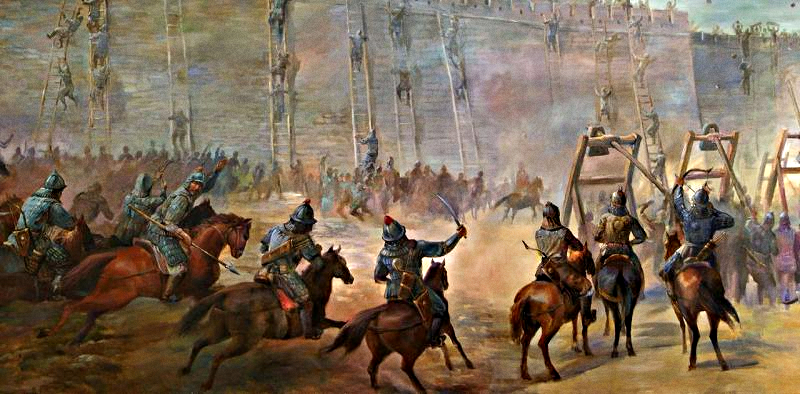
The defenders of the city realized that the incident of 1218 left them little hope for leniency and 20 thousand Kipchaks continued to fight to the death [Rashid ad-Din, 1952b, pp. 198, 199]. Betrayal of Karadzha-hajib, sent with 10 thousand soldiers to support the garrison and opened the gates to the Mongols, accelerated the death of the defenders. Gayir-sultan remained with two friends and fought until he was captured and brought to Genghis Khan, who subjected him to martyrdom. Together with him were executed surrendered 10 thousand warriors Karadzha-hajib. Genghis Khan did not like traitors and guest-killers very much.
The same fate befell the Turkic garrisons of other cities on the southern outskirts of Desht-i Kipchak, in particular Benaket, Sygnak and Ashnas [Rashid ad-Din, 1952b, p. 199-201].
Seven days and nights lasted the siege of Sygnak — the center of the Prisirdarya Kipchaks. Juchi killed all its defenders.
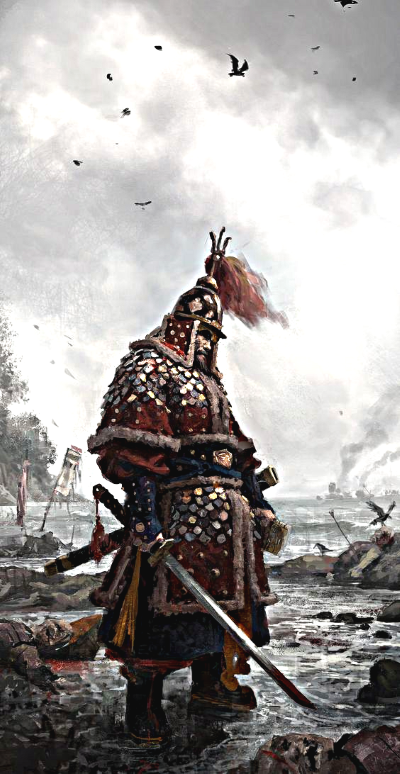
All the quoted authors describe the final drama, but, as we can judge from the stories of Rashid ad-Din about the defeat of the state of Khorezmshahs, its beginning was no less bloody. Having captured Bukhara, «[Mongols] of [Turks]-Kanglians left alive only by lot; they killed more than 30 thousand men, and women and children were taken away [with them] as slaves.» [Rashid ad-Din, 1952b, p. 206].
After the capture of Samarkand, «the rest of the population and the garrison of the citadel they drove out into the steppe, separated the Turks from the Taziks and distributed everyone into tens and hundreds. According to Mongolian custom, they [ordered] the Turks to gather and curl their hair. The rest [of the Turks]-Kanlians [numbering] more than 30 thousand people and their leaders … they killed» [Rashid al-Din, 1952b, p. 208].
A contemporary of al-Omari writes that Turkestan — «the true homeland of the Turks», «the country of heroes» — was the first to fall victim to the onslaught of the Mongols and was subjected to fierce devastation: «the sword reaped a rich harvest there, and only a few escaped it» [Lech, 1968, p. 208]. [Lech, 1968, pp. 132-133].
Historians quote lines from the letter of traveler and geographer Yakut al-Hamawi (1178/1180 — 1229), who noted that the outstanding architectural buildings Mongols «wiped off the face of the earth as lines of writing are wiped off parchment, and these abodes became a dwelling for owls and crows, in them now only siskins echo and winds moan».
Persecution of the Kipchaks
The resistance of the Kipchaks did not end there. In 1221, Juchi at the head of a large army went to the steppes of Kazakhstan to the northeast of the Aral Sea, where «the Kipchak people gathered and there was a battle. Djuchi won and killed all the Kipchaks who fell into his hands».
Apparently, the Kipchaks were forced to unite in the face of universal danger and resist the enemy. The united forces were gathered to the northeast of the Aral Sea, apparently, this is the territory of Central Kazakhstan in the area of the Ulytau mountains. However, the preponderance of forces was on the side of the Mongols, and the Kipchaks suffered another defeat.
«Most of the Kipchaks, not having resources for large-scale resistance, were forced to voluntarily recognize the power of the Chingizids, because they could not resist the victorious onslaught of the Mongol troops. Some part of the Kipchaks migrated in the northern and western directions, penetrated into the forest areas of the Ural Mountains, Priirtyshye and Priobie» [5, p. 107].
Khan Abul-Gazi wrote about the resettlement of the Kipchaks to the north: «Djuchi-khan defeated the Kipchaks; those of them who escaped went to the Ishtyaks. Most of the Ishtyaks are now descendants of those Kipchaks.»
«The Mongols, pursuing the Kipchaks, who sought salvation among other peoples, never called the Kipchaks other than their «slaves» and «stableboys», and acted with spears» [Nasavi, 1973, p. 121].
Juchi and Kipchaks
Another motivation that determined the direction and nature of the Mongol conquests was «the desire to acquire large uninhabited areas of land» [Safargaliev, 1960, p. 93] [Safargaliev, 1960, p. 93]. In the case of the Kipchaks, this desire may have been fueled by the fact that when Juchi «saw the air and water of the Kipchak land, he found that in the whole world there could be no land more pleasant than this, air better than this, water sweeter than this, meadows and pastures more extensive than these» [Tizengausen, 1941, p. 14].
Dzhuchi, as Dzhuzdzhani reports, was an opponent of total extermination of the population of the conquered territories, because this dispute in Genghis Khan’s family was going on even during the conquest of China.
However, even if we assume that Juchi was indeed lenient to the inhabitants of Desht-i Kipchak, his fate should have been a harsh lesson for his heirs, because, as many researchers believe, it was Juchi’s «softness» that later caused his death at the hands of the Kipchaks saved by him.
The exact date of Juchi’s death is not known, as well as his exact date of birth. We can only talk about the beginning of 1226 (or the end of 1225), according to some other sources — 1227. Died Djuchi approximately at the age of 40 years. He was buried in a mausoleum in the Karaganda region of Kazakhstan, 50 kilometers northeast of Zhezkazgan. In 1946 the body of Dzhuchi Khan was dug up by Soviet archeologists. In the tomb was found a skeleton without the right hand with a notched skull.

Mausoleum of Djuchi
According to the story of such a profound connoisseur of chronicles and steppe history as Abul-Gazi, the acquisition of Eastern Desht-i Kipchak by the Mongols led to the actual replacement of its population: after the end of the Central Asian campaign, «Juchi with the nukers attached to him went to Desht-i Kipchak. Djuchi, having taken all the Kipchak youth captive, settled in a Kipchak yurt. From the Mongol country he moved his family and all or which his father had given him. From each uplug of Uzbeks there were settlers in the Kypchak yurt» [Kononov, 1958, p. 44].
«According to research, the Kazakhs as an ethnogenetic collective appeared in the XIII century, when there was not yet the name «Kazakhs», but the ethnogenetic collective that we know as Kazakhs, appeared precisely when there was a mixture, conditionally speaking, of local tribes of the XIII century and incoming tribes from East Asia, which in the XIII century came to this territory»» [Sabitov, 2020].
Synopsis
In 1205, 1207-1210 the Mongols invaded the Tangut state of Western Xia (Xi Xia), but had no decisive success, a peace treaty was concluded, which obliged the Tanguts to pay tribute to the Mongols.
In 1207 a detachment under the command of Genghis Khan’s son Dzhuchi made a campaign to the north of the Selenga River and to the valley of the Yenisei River, conquering the forest tribes of the Kyrgyz, Ursuts, Tubas and others.
In winter 1208 Mongol armies crossed the Altai Mountains, pursuing the Naimans who fled westward and subduing the Uigurs. Then the hiding Yenisei Kyrgyz and Karluks joined the new power.
1211 Mongols invaded northern China, starting a war with the Jin state of Jurchen.
The Mongol conquest of the Kipchak tribes of eastern Desht-i Kipchak
In 1214-1215 Genghis Khan suppressed the rebellions of the Merkits, Tumets and other tribes and began to prepare for a campaign to the west.
In 1218-1219 Mongolian troops, pursuing a detachment of the Kidans, invaded Korea, but were defeated. The conquest of Northern China significantly strengthened the Mongol power and its army, the Mongols began to use flamethrowers and wall-breaking guns to besiege cities.
In 1218-1222 Mongolian armies under the command of Dzhebe and Subedei conquered East Turkestan and Semirechye, destroyed the Central Asian state of Khorezm, invaded Azerbaijan and Georgia, defeated Alans and Kipchaks (Polovtsians). Pursuing the Kipchaks, Dzhebe and Subedei invaded the steppes of the northern Black Sea region. Black Sea coast. Kipchak khans appealed for help to Russian princes, and the rulers of Kiev, Chernigov, Volyn and a number of other principalities agreed to support them.
In the early summer of 1223 on the Kalka River there was a battle between the Mongols and the united Russian-Polovtsian army, which ended in the defeat of the allies. Further Mongols have grasped Crimea, then have gone to the Volga where have suffered defeat in struggle with Volga Bulgars. After that Dzhebe and Subedei returned to Central Asia.
In 1221 the army of son Genghis Khan Tolui has conquered east Iran.
In the fall of 1225 Genghis Khan with the main forces of the Mongols returned to his homeland. With the help of Chinese advisers, a system of administration of the conquered peoples was built. Initially, separate settlements or territories with inhabitants were given into possession of one or another Mongolian noyon, who collected taxes from them. The Yasa was finalized, in which the duties of the conquered agricultural peoples were fixed, including a tax on the maintenance of post stations and messengers. Farmers were also conscripted into militias. Under his direct management Genghis Khan left indigenous Mongolian lands (including the territory of Southern Transbaikalia), which became the «ulus of the Great Khan». Construction of capital of Great Mongolian Empire — Karakorum began.
The conquered territories Genghis Khan gave in management to the sons, having allocated to them uluses. Djuchi received the lower reaches of the Amu Darya with Khorezm and the lower reaches of the Syr Darya, Chagatai — the territory between the Amu Darya and Syr Darya (Maverannahr), Ugedei — Western Mongolia and Tarbagatai, and Tolui — his father’s ulus.
The following years Mongols fought against the Tanguts. In 1226 they invaded the state of Western Xia, defeated the Tangut armies, sacked and burned their cities and besieged the capital. In the midst of the siege of the Tangut capital in 1227 Genghis Khan died.
In 1229, according to his will, on a hural Ugedei was proclaimed the great khan.
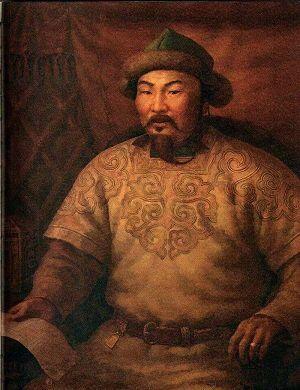
Ugedei (c. 1186 — December 11, 1241) — the third son of Genghis Khan and Borte and the successor of his father as the Great Khan of the Mongol Empire (1229-1241).
In reign of descendants of Genghis Khan Mongols conducted military campaigns on western (1236 — Volga Bulgaria; 1237-1240 — Vladimir Russia, Kievan Rus; 1241-1242 — Bohemia, Hungary, Poland, Serbia, Bulgaria), southern (till 1234 war with Jin; 1231-1241 — Korea; 1235-1279 Empire of Song) and south-western directions (1258 — Baghdad Caliphate).
By 1260th the Great Mongolian Empire has broken up on separate uluses: Empire Yuan (Mongolia and till 1368 China), the state Hulaguids (Iran and Transcaucasia) and Golden Horde (ulus Djuchi). In Transbaikalia there are known monuments of the Mongol period: Khirkhirin township, Konduisky township.
